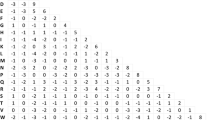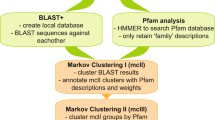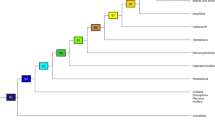Abstract
We have investigated the influence of the plasma membrane environment on the molecular evolution of G protein-coupled receptors (GPCRs), the largest receptor family in Metazoa. In particular, we have analyzed the site-specific rate variation across the two primary structural partitions, transmembrane (TM) and extramembrane (EM), of these membrane proteins. We find that TM domains evolve more slowly than do EM domains, though TM domains display increased rate heterogeneity relative to their EM counterparts. Although the majority of residues across GPCRs experience strong to weak purifying selection, many GPCRs experience positive selection at both TM and EM residues, albeit with a slight bias towards the EM. Further, a subset of GPCRs, chemosensory receptors (including olfactory and taste receptors), exhibit increased rates of evolution relative to other GPCRs, an effect which is more pronounced in their TM spans. Although it has been previously suggested that the TM’s low evolutionary rate is caused by their high percentage of buried residues, we show that their attenuated rate seems to stem from the strong biophysical constraints of the membrane itself, or by functional requirements. In spite of the strong evolutionary constraints acting on the TM spans of GPCRs, positive selection and high levels of evolutionary rate variability are common. Thus, biophysical constraints should not be presumed to preclude a protein’s ability to evolve.




Similar content being viewed by others
References
Akaike H (1974) A new look at the statistical model identification. IEEE Trans Autom Control 19:716–723
Bockaert J, Pin JP (1999) Molecular tinkering of G protein-coupled receptors: an evolutionary success. EMBO J 18:1723–1729
Buck L, Axel R (1991) A novel multigene family may encode odorant receptors: a molecular basis for odor recognition. Cell (Cambridge, MA, US) 5:175–187
Bywater RP (2005) Location and nature of the resiudes important for ligand recognition in G protein-coupled receptors. J Mol Recognit 18:60–72
Clark AG, Glanowski S, Nielsen R, Thomas PD, Kejariwal A, Todd MA, Tanenbaum DM, Civello D, Lu F, Murphy B (2003) Inferring nonneutral evolution from human–chimp–mouse orthologous gene trios. Science 302:1960–1963
Dorsam RT, Gutkind JS (2007) G coupled-protein receptors and cancer. Nat Rev Genet 7:79–94
Duret L, Mouchiroud D (2000) Determinants of substitution rates in mammalian genes: expression pattern affects selection intensity but not mutation rate. Mol Biol Evol 17:6874
Feldmesser E, Oldener T, Khen M, Yanai I, Ophir R, Lancet D (2006) Widespread ectopic expression of olfactory receptor genes. BMC Genomics 7:121138
Franzosa EA, Xia Y (2009) Structural determinants of protein evolution are context-sensitive at the residue level. Mol Biol Evol 26:2387–2395
Fredriksson R, Schioth HB (2005) The repertoire of G protein-coupled receptors in fully sequenced genomes. Mol Pharmacol 67:1414–1425
Fredriksson R, Lagerstrom MC, Lundin LG, Schioth HB (2003) The G protein-coupled receptors in the human genome form five main families. Phylogenetic analysis, paralogon groups, and fingerprints. Mol Pharmacol 63:1256–1272
Gilad Y, Segre D, Skorecki K, Nachman MW, Lancet D, Sharon D (2000) Dichotomy of single-nucleotide polymorphism haplotypes in olfactory receptor genes and pseudogenes. Nat Genet 26:221–224
Gilad Y, Man O, Glusman G (2005) A comparison of the human and chimpanzee olfactory receptor gene repertoires. Genome Res 15:224–230
Gimelbrant AA, Skaletsky H, Chess A (2004) Selective pressures on the olfactory receptor repertoire since the human–chimpanzee divergence. Proc Natl Acad Sci USA 101:9019–9022
Goldman N, Yang Z (1994) A codon-based model of nucleotide substitution for protein-coding DNA sequences. Mol Biol Evol 11:725–736
Julenius K, Pedersen AG (2006) Protein evolution is faster outside the cell. Mol Biol Evol 23:2039–2048
Kabsch W, Sander C (1983) Dictionary of protein secondary structure: pattern recognition of hydrogen-bonded and geometrical features. Biopolymers 22:2577–2637
Katoh K, Misawa K, Kuma KI, Miyata T (2002) MAFFT: a novel method for rapid multiple sequence alignment based on fast Fourier transform. Nucleic Acids Res Suppl 30:3059–3066
Kosakovsky Pond S, Frost SDW (2005) Not so different after all: a comparison of methods for detecting amino acid sites under selection. Mol Biol Evol 22:1208–1222
Kosakovsky Pond SL, Frost SDW, Muse SV (2005) HyPhy: hypothesis testing using phylogenies. Bioinform Biol Insights 12:676–679
Kristiansen K (2004) Molecular mechanisms of ligand binding, signaling, and regulation within the superfamily of G protein-coupled receptors: molecular modeling and mutagenesis approaches to receptor structure and function. Pharmacol Ther 103:21–80
Lagerstrom MC, Schioth HB (2008) Structural diversity of G protein-coupled receptors and significance for drug discovery. Nat Rev Drug Discov 7:339–357
Liao BY, Scott NM, Zhang J (2007) Impacts of gene essentiality, expression pattern, and gene compactness on the evolutionary rate of mammalian proteins. Mol Biol Evol 24:2072–2080
Lu ZL, Hulme EC (2000) A network of conserved intramolecular contacts defines the off-state of the transmembrane switch mechanism in a seven-transmembrane receptor. J Biol Chem 275:5682–5686
May LT, Leach K, Sexton PM, Chistopoulus A (2007) Allosteric modulation of G protein-coupled receptors. Annu Rev Pharmacol Toxicol 47:1–51
Meyer AG, Wilke CO (2012) Integrating sequence variation and protein structure to identify sites under selection. Mol Biol Evol
Mombaerts P (2004) Genes and ligands for odorant, vomeronasal and taste receptors. Nat Rev Neurosci 5:263–278
Nei M, Niimura Y (2007) Extensive gains and losses of olfactory receptor genes in mammalian evolution. PLoS ONE 2:e708
Nielsen R, Yang Z (1998) Likelihood models for detecting positively selected amino acid sites and applications to the HIV-1 envelope gene. Genet Mol Res 148:929–936
Nielsen R, Bustamante C, Clark AG, Glanowski S, Sackton TB, Hubisz MJ, Fiedel-Alon A, Tanenbaum DM, Civello D, White TJ (2005) A scan for positively selected genes in the genomes of humans and chimpanzees. PLoS Biol 3:e170
Niimura Y, Nei M (2003) Evolution of olfactory receptor genes in the human genome. Proc Natl Acad Sci USA 100:12,235–12,240
Oberai A, Joh NH, Pettit FK, Bowie JU (2009) Structural imperatives impose diverse evolutionary constraints on helical membrane proteins. Proc Natl Acad Sci USA 106:17,747–17,750
Pal C, Papp B, Lercher MJ (2006) An integrated view of protein evolution. Nat Rev Genet 7:337–348
Park PSH, Lodowski DT, Palczewski K (2008) Activation of G protein-coupled receptors: beyond two-state models and tertiary conformational changes. Annu Rev Pharmacol Toxicol 48:107–141
Penn O, Privman E, Landan G, Graur D, Pupko T (2010) An alignment confidence score capturing robustness to guide tree uncertainty. Mol Biol Evol 27:1759–1767
Privman E, Penn O, Pupko T (2012) Improving the performance of positive selection inference by filtering unreliable alignment regions. Mol Biol Evol 29:1–5
Ramsey DC, Scherrer MP, Zhou T, Wilke CO (2011) The relationship between relative solvent accessibility and evolutionary rate in protein evolution. Genet Mol Res 188:479–488
Rosenbaum DM, Rasmussen SGF, Kobilka BK (2009) The structure and function of G protein-coupled receptors. Nat Biotechnol 459:356–363
Schoneberg T, Schulz A, Biebermann H, Hermsdorf T, Rompler H, Sangkuhl K (2004) Mutant G protein-coupled receptors as a cause of human diseases. Pharmacol Ther 104:173–206
Spalding TA, Burstein ES, Henderson SC, Ducote KR, Brann MR (1998) Identification of a ligand-dependent switch within a muscarinic receptor. J Biol Chem 273:21,563–21,568
Stamatakis A (2006) RAxML-VI-HPC: maximum likelihood-based phylogenetic analyses with thousands of taxa and mixed models. Bioinform Biol Insights 22:2688–2690
Stevens TJ, Arkin IT (2001) Substitution rates in alpha-helical transmembrane proteins. Prot Sci 10:2507–2517
Surgand J, Rodrigo J, Kellenberger E, Rognan D (2006) A chemogenomic analysis of the transmembrane binding cavity of human G protein-coupled receptors. Proteins Struct Funct Genet 62:509–538
Tien M, Meyer AG, Spielman SJ, Wilke CO (2012) Maximum allowed solvent accessibilites of residues in proteins. ArXiv:1211.4251 [q-bio.BM]
Tourasse NJ, Li WH (2000) Selective constraints, amino acid composition, and the rate of protein evolution. Mol Biol Evol 17:656–664
Vaidehi N, Floriano WB, Trabanino R, Hall SE, Freddolino P, Choi EJ, Zamanakos G, Goddard III WA (2002) Prediction of structure and function of G protein-coupled receptors. Proc Natl Acad Sci USA 99:12,622–12,627
Vanderhaeghen P, Schurmans S, Vassart G, Parmentier M (1997) Specific repertoire of olfactory receptor genes in the male germ cells of several mammalian species. Genomics 39:239–246
Vilella AJ, Severin J, Ureta-Vidal A, Heng L, Durbin R, Birney E (2008) EnsemblCompara GeneTrees: complete, duplication-aware phylogenetic trees in vertebrates. Genome Res 19:327–335
Wistrand M, Käll L, Sonnhammer ELL (2006) A general model of G protein-coupled receptor sequences and its application to detect remote homologs. Prot Sci 15:509–521
Yang Z, Nielsen R, Goldman N, Krabbe Pedersen AM (2000) Codon-substitution models for heterogeneous selection pressure at amino acid sites. Genet Mol Res 155:431–449
Zhang X, De la Cruz O, Pinto JM, Nicolae D, Firestein S, Gilad Y (2007) Characterizing the expression of the human olfactory receptor gene family using a novel DNA microarray. Genome Biol 8:R86
Acknowledgments
This work was supported by NIH grant R01 GM088344 to C.O.W. We thank Austin G. Meyer for his thoughtful comments.
Author information
Authors and Affiliations
Corresponding author
Electronic supplementary material
Below is the link to the electronic supplementary material.
Rights and permissions
About this article
Cite this article
Spielman, S.J., Wilke, C.O. Membrane Environment Imposes Unique Selection Pressures on Transmembrane Domains of G Protein-Coupled Receptors. J Mol Evol 76, 172–182 (2013). https://doi.org/10.1007/s00239-012-9538-8
Received:
Accepted:
Published:
Issue Date:
DOI: https://doi.org/10.1007/s00239-012-9538-8




